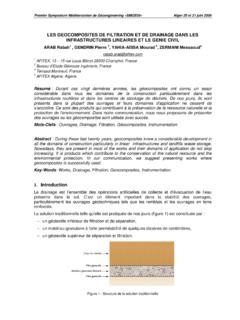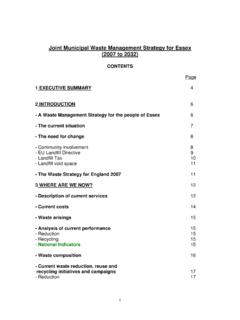Transcription of Innovative Approach to Landfill Gas Collection and …
1 Geosynthetics 2015 February 15-18, Portland, Oregon Innovative Approach to Landfill Gas Collection and Control E. S. Steinhauser, Sanborn, Head & Associates, Inc., USA, S. Fourmont, AFITEX-TEXEL, Inc., Canada, ABSTRACT Landfill gas (LFG) needs to be effectively extracted from active and closed landfills to comply with air quality regulations as well as to fuel beneficial uses. LFG extraction is performed by applying a vacuum to vertical wells and Collection trenches or other Landfill related infrastructure. LFG Collection trenches are semi-permanent features used to control LFG emissions prior to installing wells. LFG Collection trenches are constructed by excavating a trench into the waste mass and installing a perforated pipe bedded in and backfilled with aggregate.
2 Each year miles of trenches are constructed in landfills requiring the excavation and relocation of significant volumes of waste. While LFG Collection trenches are an important component to a well-operated Landfill , there is significant cost associated with constructing trenches and relocating waste. This paper examines the use of a tubular drainage geocomposite as a LFG Collection and conveyance medium. 1. INTRODUCTION Landfill gas (LFG) is produced during the decomposition of putrescible material in landfills. Often referred to as biogas, LFG is a source of odors and greenhouse gases. LFG is typically 40 to 60 percent methane with the remainder consisting of carbon dioxide with lesser concentrations of atmospheric gases ( , oxygen and nitrogen) and trace concentrations of other constituents ( , hydrogen sulfide, siloxanes).
3 Methane is a greenhouse gas that has 25 times more of an impact on climate change than carbon dioxide (USEPA, 2013). LFG must be removed from the Landfill to reduce or eliminate odors, and to limit the migration of methane to the atmosphere or nearby structures, which could result in an explosive hazard. Federal and state regulations address the Collection and control of LFG, and Landfill owners and operators may be required to apply for air quality permits. As such, the management of LFG at landfills is an important, and often costly, operational aspect of a well-run Landfill . The need to install a gas Collection and control system (GCCS) is dependent on the amount and type of waste accepted.
4 Once installed, a properly designed and constructed GCCS can be an integral part of an environmentally sound waste material management operation. Typically, LFG is controlled by an active or passive gas system. A passive system consists of vents that emit LFG into the atmosphere; whereas an active system extracts LFG by applying a vacuum to a network of Collection wells and trenches. In an active system, LFG is collected and sent to a destruction device, such as a flare, where it is combusted and the methane is converted to carbon dioxide. Because of the energy potential of the methane gas, Landfill gas-to-energy (LFGTE) projects have been developed to capitalize on the man-made green fuel source.
5 In general, LFGTE projects use the LFG to fuel specially designed turbines, reciprocating engines, or boilers. LFGTE projects can have design lives in excess of 20 years and range in size from a few kilowatts to 10 or more megawatts. Also, LFG can be processed into a compressed gas for vehicle use. The success of a LFGTE project is directly related to the performance of the GCCS. Traditional methods of LFG Collection can be time consuming and expensive to install, and installation sometimes can be delayed due to seasonal and budget issues. This paper presents a geosynthetic solution that Landfill owners and operators can cost effectively employ in their GCCS to enhance the success of their LFGTE projects as well as maintain compliance with regulatory requirements.
6 2. CURRENT Landfill GAS CONTROL PRACTICES There are several approaches to collecting LFG, including: (i) a gas Collection layer within the final cover system; (ii) Collection trenches within the waste mass; and (iii) vertical extraction wells. Some states require that the Landfill final cover system include a granular gas venting layer below the cap geomembrane. While the required thickness of this section may vary from state to state (152 to 305 millimeters [mm]), this layer can be an expensive component of the final cover system, and may be difficult to construct. 283To reduce nuisance odors, gas Collection trenches are often installed at some landfills to intercept fugitive emissions from the surface of the Landfill .
7 Construction of a typical LFG Collection trench involves waste excavation and relocation, and the purchase and installation of perforated high-density polyethylene (HDPE) pipe and drainage aggregate. The perforated pipe is typically connected to solid HDPE pipe and a wellhead, through which vacuum, and hence the gas Collection rate, can be monitored and controlled. It is common to space the LFG Collection trenches about 15 to 30 meters (m) apart horizontally and about 9 to 12 m vertically (see Figure 1). Closer spacing is sometimes used when more aggressive odor reduction measures are needed. Each Collection trench has a zone of influence, in which the vacuum that is applied to the trench influences the movement of LFG within the Landfill .
8 Maintaining this spacing is important for efficient LFG Collection . Figure 1. Typical LFG Collection trench layout. Typically, gas Collection trenches (Figure 2) are designed to include: a wide by to 2-meter deep trench into existing waste along the length of the gas Collection trench; a 152-mm diameter perforated HDPE pipe along length of the trench; with aggregate surrounding the pipe within the trench section. Some trench designs include a nonwoven geotextile separator placed between the aggregate and the waste. Figure 2. Typical gas Collection trench section. 3. ALTERNATE Landfill GAS CONTROL USING GEOSYNTHETICS As noted above, the final cover gas venting layer and the gas Collection trenches often include granular materials.
9 As with many other aspects of Landfill design, it is possible to use a geosynthetic material to completely replace, or at least greatly 284reduced the thickness of, the granular layer. Planar drainage geocomposite materials typically used in Landfill leachate Collection and final cover drainage layers consist of nonwoven geotextile heat bonded to one or both sides of a geonet. The effectiveness of such materials may be reduced in some applications, notably under high normal stresses that can cause intrusion of the geotextiles into the open spaces of the geonet, thereby reducing the transmissivity of the geocomposite. For GCCS applications addressed in this paper, a tubular drainage geocomposite (illustrated in Figure 3), provides an effective design alternative to promote LFG Collection .
10 Tubular drainage geocomposites combine the fluid flow characteristics of geotextiles and pipe. As shown in Figure 3, the tubular drainage geocomposite is comprised of small diameter pipes (mini-pipes) positioned between two nonwoven geotextiles. Tubular drainage geocomposites have been used in Landfill applications in Europe and Africa for nearly 20 years. An important characteristic of tubular drainage geocomposites is that they maintain their transmissivity under significant normal stresses (Saunier, et. al., 2010) in large part because they don t experience geotextile intrusion into the primary high-flow component. Therefore, for most of the applications, the applied combined reduction factors for tubular drainage geocomposite are almost half of those applied to standard geonet geocomposites (Maier, et.)




